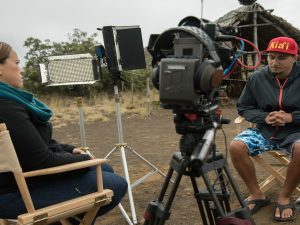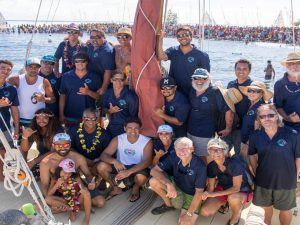“When we went down to Kaʻū, we sailed and got to see all of the volcanoes, erupting and flowing into the ocean. I was on Hoʻokela, but, I have this beautiful image of Hōkūleʻa and Hikianalia in the background with just this steam, of the lava going into the ocean, and no people, just lava. Thatʻs kind of what I imagine what it would have been like to have seen Hawaiʻi for the first time, with the first Hawaiians,” said Haunani Kane, an apprentice navigator on Hōkūleʻa
“The canoe has always been there since the beginning of Hawaiʻi. I can only see that it becomes more relevant than it has been already,” said apprentice navigator Lehua Kamalu.
As Hōkūleʻa and Hikianalia made their way across the Hawaiian islands last year, their paths intertwined, bridging the past with the present, using traditional knowledge to face modern environmental issues. This kuleana became a journey called Mālama Hawaiʻi, the first leg of their larger Worldwide Voyage.
It is a voyage that intends to bring respect and aloha and to make sure that our communities knew that we took the time and we took the effort, we took the energy to connect with them, to link with them and to in a respectful, humble way, to explain why we are doing this voyage,” said master navigator Nainoa Thompson.
“Kaho’olawe, Kealaikahiki, that name, that place, the pathway that story of the island itself, the healing of the island. I think a lot of us can relate to that and that’s what we’re looking for too, with this world voyage is stories of hope, taking care of our place even if maybe, it wasn’t taken care of. But there is hope that life can come back to places that have suffered,” said Kaʻiulani Murphy a navigator on Hōkūleʻa.
This hope lies within the many generations who will follow in the wake of Hōkūleʻa and Hikianalia in continuing this ʻike that is unique to our Hawaiʻi, but relevant around the world.
“I think that was one of the really amazing features of this past voyage. In getting all these 20,000 kids out. Any child can touch the canoe, any child can be on it. It’s something that is closer to them, and just gives them that daily pride, and that confidence,” said Lehua.
“Having our haumāna, having our kamaliʻi from Miloliʻi to be able to witness Hōkūleʻa coming in today, it was such a blessing, and you could see the excitement in their faces cause now that circle has come fully around,” said Lei Kaupu, a teacher from Miloliʻi.
“In the last Mālama Hawaiʻi, when we went to all these communities, you had people from all walks of life come together and sit on the same deck,” said Lehua.
“People have responded, and long after the voyage, we are going to be connected with these communities still around the world and be able to see those ripple effects, 20 years, 50 years down the road,” said Jenna.



